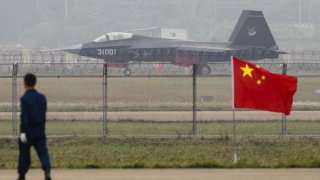China’s Economic Slowdown is Strengthening its Defense Industrial Base
As Beijing deprioritizes the real estate sector, it is doubling down on investment in science, technology, and national defense.
In 2023, China’s economy grew at the slowest pace since 1990, apart from two years during the COVID-19 pandemic when the country was closed to the outside world. For many observers in the United States, China’s economic woes are a welcome development.
But China’s slowdown masks a worrisome trend under the surface: Beijing is pouring investment into high-tech manufacturing at an accelerating pace. While China’s real estate sector faces pressure, its defense industrial base continues to expand. As a result, China’s new industrial policy could help it narrow the capabilities gap with the United States.
China’s blistering growth over the last couple of decades was destined to slow down. Following the global financial crisis, debt levels in China soared while returns on investment, especially in the property sector, fell. Aware of these imbalances, in 2020, Beijing clamped down on over-leveraged developers by enacting new borrowing limits, also known as the “three red lines.” This policy set off a spiral of falling property prices and investment.
As Beijing deprioritizes the real estate sector, it is doubling down on science, technology, and national defense. In 2023, property investment declined by 9.6 percent, while investment in “high-tech manufacturing” grew by 9.9 percent. Weakness in the property sector is freeing up resources—land, labor, capital, and intermediate inputs—to invest in dual-use sectors. Growth was particularly strong in industries like aviation, electronics, and communication equipment. By next year, the government plans to raise the output of “strategic emerging industries” as a share of GDP from 13 percent to 17 percent.
In January, the Pentagon released the United States’ first National Defense Industrial Strategy, noting that China’s production capacity in sectors like shipbuilding, critical minerals, and microelectronics “vastly exceeds” that of “not just the United States, but the combined output of our key European and Asian allies.” Another report published by the Center for Strategic and International Studies states that the People’s Liberation Army (PLA) is “acquiring high-end weapons systems and equipment five to six times faster than the United States.” In the event of a prolonged conflict, the United States may be unable to match the speed and scale of China’s weapons procurement.
For this reason, comparing the U.S. and Chinese economies on the basis of nominal output obscures more than it reveals; the composition of the economies matters, too. Under a classic “guns versus butter” model, an economy with fixed production capacity faces a trade-off between producing commercial and military products.
Historically, the United States’ dominant industrial base allowed it to play a pivotal role in great power wars. During World War II, the United States supplied two-thirds of the Allies’ war materiel: 86,000 tanks, 286,000 aircraft, 2.5 million trucks, 434 million tons of steel, and 41 billion rounds of ammunition. Today, the United States’ consumer and services-led economy is ill-suited to sustain a major war.
China, by contrast, now accounts for 31 percent of global manufacturing, even as its industrial capacity utilization runs below potential. Continued investments in advanced manufacturing will only further enhance China’s strategic capacity.
From a market perspective, overcapacity can lead to deflation and declining profitability. However, in the context of international competition, excess capacity is an advantage. The ability to field capabilities in the event of a war matters more than the ability to raise total factor productivity or sustain headline economic growth.
As Beijing shifts investment from the real estate sector, it is targeting “core technologies” that will enhance its national security. China’s 2024 fiscal budget earmarked a 10 percent increase in funding for science and technology, the highest growth rate of any category, followed by energy and food reserves and national defense. Priority areas include AI, quantum computing, high-end chips, biomedicine, new materials, and aerospace. In a recent meeting with representatives of the People’s Liberation Army (PLA), Xi Jinping stressed that “strategic capabilities in emerging fields are an integral part of…national security and military initiative.”
China’s focus on defense industrial policy is not new. Its current approach can be traced back to the Mao-era program of “Two Bombs, One Satellite,” which resulted in the deployment of China’s first homegrown satellite and atomic and hydrogen bombs. To this day, China’s leadership describes its ability to “concentrate efforts on major tasks” as a “magic weapon.” Scholar Tai Ming Cheung labels the People’s Republic of China as a “techno-security state” due to its tendency to devote significant state resources to defense innovation.
Of course, China’s defense base is not without challenges. The PLA continues to rely on imported components such as avionics, nuclear submarine engines, and advanced chips. China also lacks modern experience in placing its vast industrial base on a wartime footing. Finally, the slowdown in the property market is dampening private investment throughout the economy, including in strategic domains. While the government is trying to fill the gap with top-down investments, there is no guarantee that these efforts will be successful. Decades-long projects to achieve self-sufficiency in areas like commercial aviation and advanced chips have been accompanied by significant waste.
Ultimately, though, the efficiency of China’s industrial policy is less critical than the country’s ability to field capabilities with speed and at scale. Regardless of whether China’s state-guided investments are efficient, they will still expand the country’s defense industrial capacity. So, although China’s economy may be slowing, the government’s ability to marshal resources to achieve national objectives is far from diminished.
Nathaniel Sher is a senior research analyst at Carnegie China, where he researches China’s foreign policy and U.S.-China relations. Nathaniel received MAs from Tsinghua University and the University of Chicago. Follow him on X: @Nathaniel_Sher.
Image: Shutterstock.com.

